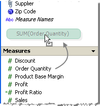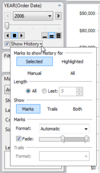Tips & Tricks Flashcards

In addition to dragging measures onto shelves, you can drag measures onto the axis created by a previous measure. This allows multiple measures to share a single axis.
In the example below, both the Sales field and the Profit field share a common axis. This view was created by dragging the Sales field to the Row Shelf and then dragging the Profit field onto the axis created by the Sales field. The result is the creation of a “multiple measures” axis that is labeled ‘value.’

By default, Tableau treats all relational fields containing numbers as measures. However, you might decide that some of these fields should be treated as dimensions. For example, a field containing ages may be categorized as a measure by default in Tableau because it contains numeric data. However, if you want to look at each individual age rather than an axis you can convert the Age field to a dimension. Convert a measure to a dimension by dragging it from the Measures area to the Dimensions area in the Data window.

By default, Tableau treats all relational fields containing text or date values as dimensions. However, you might decide that some of these fields should be treated as measures. For example, a field that contains sales figures with null values represented as “N/A” or “*” may be categorized as a dimension by default in Tableau because it contains text values. You can convert the dimension to a measure first by changing the data type to a number and then by dragging it from the Dimensions area to the Measures area in the Data window.

You can duplicate any worksheet in Tableau as a cross-tab by right-clicking the worksheet tab and selecting Duplicate as Cross-tab. The result will contain only dimensions in the Rows and Columns shelves. If measure names are part of the original view, they will be displayed in the cross-tab using the Measure Names field.
You can also export a cross-tab directly to Microsoft Excel by selecting File > Export > Cross-tab to Excel

Manually sorting the items in the color legend change the drawing order of a field so you can see obscured data in your views. For instance, if you can’t see green marks in a scatter plot because they are obscured by orange marks, you can manually sort the items in the color legend so that the green points are drawn on top of the orange points. The marks are drawn in the view according to the order in the legend, from bottom to top. You can manually sort a color legend simply by dragging and dropping the items in the legend.

Once you add fields to the view, you can duplicate them simply by hold down the Ctrl key on your keyboard while you drag it to another shelf. For example, in the view below, the SUM(Profit) field is duplicated and placed on the Text shelf.

When you have several views in a dashboard, you can click and drag the divider lines to resize each area of the dashboard. Typically, dragging a divider line resizes the entire row or column area, as shown below:

When you publish a large view to a PDF, the entire view is either scaled to fit on a single page or the page size is scaled to fit the view. Either way, the view is not split well across several printable pages. You can use the pages shelf to split the report into meaningful sections that are then split into a multiple page PDF report. For example, the view below show the total monthly expenses by Product and Market. When published to a PDF, the page is really long.
To specify page setup for multiple worksheets:

Hold the Ctrl key on your keyboard and select one ore more worksheets that you want to specify the page setup for.
Select File > Page Setup.
Make the necessary changes in the Page setup dialog box and click OK.
Before printing a single worksheet or several worksheets, you can specify how you want the document to look when printed using the Page Setup options. For example, you can specify whether to include the legends, titles, captions, margins, page orientation, and more. Each worksheet can have its own page setup. However, often you will want to specify global page setup options. Hold the Ctrl key to select one or more worksheets and then set the page setup options.


